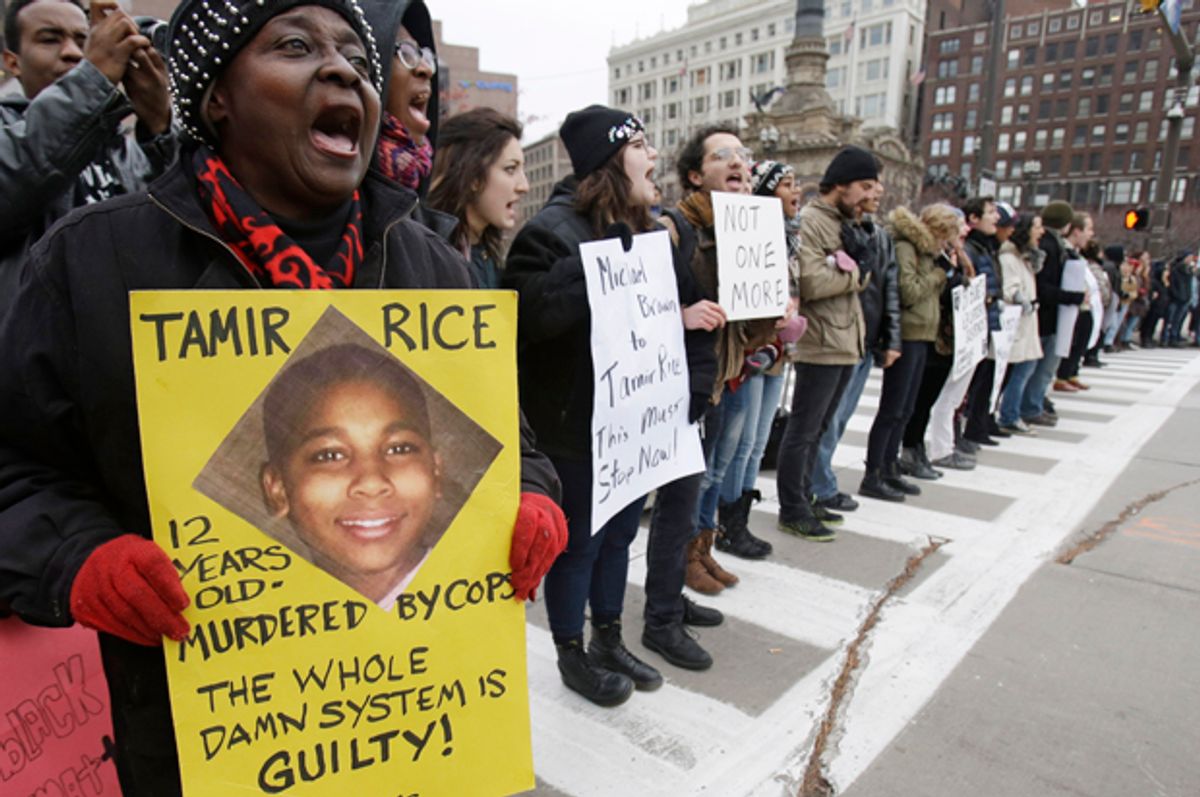Cleveland city officials have released a video showing police officers tackling the 14-year-old sister of Tamir Rice in the moments after officer Timothy Loehmann fatally shot her 12-year-old brother. In the footage, Rice’s sister can be seen running to the scene. As she approaches, an officer forcefully brings her to the ground. Another officer approaches and continues to hold her down. She’s handcuffed and put into the back seat of the patrol car. Loehmann, meanwhile, stands idly nearby Rice’s bleeding, dying body.
Walter Madison, a lawyer for Rice’s family, called the officers’ treatment of the 14-year-old “the cruelest thing I've ever seen on video.”
The recent deaths of Rice, Mike Brown, Akai Gurley and Eric Garner have ignited a national movement against lethal police violence that overwhelmingly targets black people of all ages and genders. Sustained protest has kept the issue in the news, front and center, particularly among a white public that is often quick to look away. The video of Rice’s sister is yet another reminder of how police force, even when non-lethal, can be abusive, violent and vile.
Within two seconds of arriving on the scene, Loehmann escalated his encounter with Rice, a kid holding a toy gun, to a fatal shot to the child’s abdomen. A moment later, his fellow officers escalated their encounter with his sister, using full force to restrain and detain a teenage girl who was likely acting on instinct to run to her dying brother’s side.
We saw this wild use of excessive, non-lethal force again in New York last month in a video revealing multiple officers present during the arrest of a teenage boy on the Lower East Side. A plainclothes officer can be seen on the video repeatedly punching the teenager while an onlooker yells, “"Hey, hey, hey! Stop it! Get off of him!" There are several officers visible in the footage. All of this in response to two teenagers suspected of assault. The ratio of police to suspects, already detained and not resisting, is excessive to say the very least.
As the nation’s focus remains, rightly, on the police who kill with impunity and the systems that shield them from accountability, these incidents of aggressive and excessive force that don’t result in death need to be equally front and center. Both are revealing of a police culture that is failing, repeatedly, to exercise restraint, to properly size up situations and determine the response that will be safest, and in the best interest of the community and people they are paid to serve.
In the wake of the killing of Mike Brown, the Los Angeles Police Department announced it would issue body cameras and tasers to every officer in order “reduce the risk of injuries to both our officers and the members of our community, while improving trust within our communities.” But while police equipped with military-grade weapons and a reflexive tendency to use their guns at the smallest provocation poses a grave danger, so too do police who use violent, aggressive, non-lethal force that is wildly out of proportion to the incident at hand. Body cameras and tasers won’t solve that.
The death or Eric Garner more than illustrates the problem. In that incident, there were no guns drawn, no shots fired. Pretend for a moment that Garner had survived after being put into a banned chokehold by officer Daniel Pantaleo on Staten Island. The footage would still alarm. The force would have still been excessive. Remember that Garner was approached by a plainclothes officer who recognized him as a guy who sold loose cigarettes. After swatting away the hand of an officer trying to detain him, he was put into a chokehold by Pantaleo while four other cops held him down on his stomach. They stayed there, on top of Garner, while he strained out the words, “I can’t breathe.”
The deaths of these men and boys are unacceptable, but so is the aggressive, excessive policing and a complete lack of judgment that characterizes the non-lethal but still violent interactions that seem all too common among police. Cleveland Mayor Frank Jackson said in a statement that the investigation into the shooting was turned over to the Sheriff's Department to "ensure that transparency and an extra layer of separation and impartiality were established" and to "ensure accountability in a use of force investigation." But the shot that killed Tamir Rice wasn't the only use of force that day. Tamir Rice's sister was tackled, handcuffed and detained when she came upon her brother's dying body. Rice's mother, Samaria, was also threatened with arrest when she arrived on the scene. The officers waited four minutes before attempting to administer first aid. These are all different faces of the same use of blind force. Will the investigation reflect that?

Shares